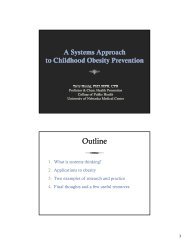Rethinking Child Custody, Domestic Violence - Rutgers NJAES ...
Rethinking Child Custody, Domestic Violence - Rutgers NJAES ...
Rethinking Child Custody, Domestic Violence - Rutgers NJAES ...
You also want an ePaper? Increase the reach of your titles
YUMPU automatically turns print PDFs into web optimized ePapers that Google loves.
children, sometimes followed by the man’s suicide. The controlling husband may obsessover his loss, deprive himself of food or other basic necessities, “slip” in his personalhygiene, and experience many of the same health and behavioral symptoms due to theloss of control over his partner that we observe in women who are being abused. Some ofthese men believe, “I am nothing without her.” Even where violence is not the result, theman who blames his wife for disloyalty or abandonment may seek to sustain control overhis partner through extended custody battles in which children in whose upbringing hehas shown little previous interest suddenly become mere pawns, an example of “childabuse as tangential spouse abuse.” Violent outbursts can sometimes be occasioned by anordinary sense of mourning for which arrangements for “parallel parenting” may beappropriate. But Gould et al. provide no clues about how to distinguish this possibilityfrom the far more dangerous—and in all probability more common-- violenceprecipitated by a perceived loss of illegitimate control.If there is no empirical evidence that abuse in the custodial setting has a uniquedynamic, there is good reason to believe it is as or even more dangerous than the violenceseen elsewhere in the service system. Data from hospitals, arrests or from criminal courtshow that domestic violence almost never appears as an isolated incident. Instead, it istypically repeated in abuse cases and frequently involves “serial abuse,” with as many as35% of victims in cases where men are arrested reporting being abused daily (Brookoff etal.. l997). Presumably Gould et al.’s rejoinder to this data is that it is culled from“clinical” instead of “community” samples. However, while abused women identified incross-sectional population studies report lower frequency rates of victimization than“clinical” samples, these histories are still sufficiently impressive to justify universal










